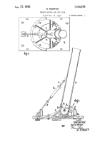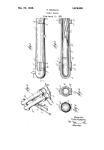/
Tags: weapons military affairs patent mortar
Year: 1927
Text
1,633,710
June 28, 1927.
H. NEWTON
TRENCH MORTAR AND THE LIKE
Original Filed Nov. 17, 1917
Patented June 28, 1927. 1,633,710
UNITED STATES PATENT OFFICE.
HENRY NEWTON, OE DABLEY, NEAB DEBBY, ENGLAND.
TBENCH MOBTAB AND THE LIKE.
Original application filed November 17, 1917, Serial No. 202,475, and in Great Britain March 22, 1916.
Divided and this application filed March 11, 1922. Serial No. 543,001.
(GRANTED UNDER THE PROVISIONS OF THE ACT OF MARCH 3, 1921, 41 STAT. I., 1313.)
This invention relates to charges for trench
mortars or other low pressure guns and has
for its object to provide arrangements of
propellant charges which will operate satis-
5 factorily in smooth bore mortars and in
which the quantity of propellant may be
varied to suit varying ranges of target and
which will also operate more satisfactorily
in use under varying conditions.
!° The invention consists in a charge for
trench mortars or other low pressure guns
comprising a plurality of separate and dis-
tinct parrs, one or more primary charges
and one or more secondary charges, the pri-
16 mary charge or charges burning rapidly and
thereby creating a temperature and pressure
environment proper to ensure the complete
combustion of the secondary charge, or
charges.
20 The invention also consists in a charge of
the above character in which the primary
charge or charges may be confined in a com-
bustion chamber.
The invention further consists in a charge
26 of the above character in which the primary
charge or charges may be carried in a com-
bustion chamber provided upon the base of
the projectile.
The invention still further consists in a
30 charge for trench mortars or other high or
low pressure guns in which the combustion
chamber carrying the primary charge is pro-
vided with ports for the emission of the pro-
pellant gases.
35 The invention also consists in other de-
tails and arrangements hereinafter described
or indicated.
My invention will now be described with
reference to the accompanying drawings, in
40 which:— . .
Figure 1 shows one form of charge in ac-
cordance with the invention adapted to be
used with a gun of the trench mortar type;
Figure 2 shows a modified form of charge;
40 Figure 3 shows a further modification of
the invention as applied to a projectile pro-
vided with wings or vanes.
In carrying my invention into effect in
one convenient manner as illustrated in Fig-
®® ure 1, I provide upon the base of the pro-
jectile a a cylindrical or other extension b
having gas emission ports b' provided there-
in and adapted to receive the primary charge
or charges c which may be ballistite or other
similar explosive contained within the car- 55
tridge container d, a secondary charge e be-
ing provided surrounding the extension Ъ in
the manner shown. If desired, the secondary
charge e may comprise two or more parts.so
that it may be varied as may be required for 60
variation in range, and the said secondary
charges may further be of any suitable form.
If necessary or desirable, both primary and
secondary charges may be located in the
breech or base chamber of the gun instead 65
of being placed at the base of the projectile.
In the1 form shown, wherein the projectile
carries its own propellant charge, the mortar
or like gun is provided with the usual striker
pin fixed at the bottom of the barrel or, if TO
desirable, the cartridges may be provided
with a self-contained striker, in which case a
flat topped stud or anvil only is fixed in the
mortar, whereby the primer f attached to the
base of the projectile is adapted to be fired TO
when the projectile falls to the lower end of
the barrel under the action of gravity.
Again, the shell may carry a trip mecha-
nism preferably adjustable so that it might
operate the igniting cartridges at predeter- so
mined points, giving a shorter or longer
stroke for the shell, as may be required for
range.
If desired, the charge may comprise a sec-
ondary slow burning charge or charges, such 85
as cordite, and a primary quick burning
charge or charges, such as gun-cotton yarn.
In the modification shown in Figure 2, the
extension b containing the primary charge
may be provided with ports g located at a 96
part adjacent the point of ignition of the
propellant whereby the pressure and temper-
ature of the propellant gases may be in-
creased.
I am well aware of the common use of a 95
primer as a means of igniting a large charge
from a percussion cap, and I make no claim
herein to such, primers, which are merely a
means of applying a flame to the surface of
the charge. 100
Figure 3 shows an arrangement where-
by the invention is applied to a projectile
provided with blades or vanes. In this case
the propellant charge comprises secondary
charges of slow burning explosive j, such as Ю5
cordite, and primary charges of quick burn-
2,633,710
slow burning or quick burning propellants 45
as may be found necessary, such modifica-
tions coming within the scope of the inven-
tion.
Having now described my invention, what
I claim as new and desire to secure by Let- 50
ters Patent is:—
1. A charge for trench mortal’s and other
low pressure guns comprising a metal con-
tainer having gas apertures, a primary
charge within said container, and a second- 55
ary charge spaced from said primary charge
by said container.
2. A projectile for trench mortars and
other low pressure guns comprising a body
portion containing explosive, a metal con- eo
tainer at the rear end of said body portion
having gas apertures, a primary charge in
said container, and a secondary charge
spaced from said primary charge by said
container. вб
3. A projectile for trench mortars and
other low pressure guns comprising a body
portion containing explosive, tail vanes se-
cured upon the end of said body portion,
and a propellant charge located and retained 70
between said vanes.
4. A projectile for trench mortars and
other low pressure guns comprising a body
portion containing explosive, tail vanes se-
cured upon the end of said body portion, 75
and a propellant charge formed in a plural-
ity of distinct parts ' located and retained
between said vanes.
5. A projectile for trench mortars and
other low pressure guns comprising a body 80
portion, tail vanes secured thereon, a pri-
mary charge adapted to burn rapidly, a
secondary slower burning charge located
and retained in proximity to said primary
charge between said tail vanes. S5
In testimony whereof I have signed my
name to this specification.
HENRY NEWTON.
S
ing explosive /, such as gun-cotton yarn,
each of these charges bping sewn or sealed up
in a separate muslin or cellulose or other
bag; it being obvious, however, that both the
primary charge or charges and the secondary
charge or charges may be inserted in a sin-
gle' bag, the charges being located between
the blades or vanes I having holes or slots n
provided on their outer edges, as shown,
through which wire or other binding mate-
rial may be passed for the purpose of secur-,
ing the bags to the projectile, it being un-
derstood that the bags containing the
charges may be formed of any suitable ma-
terial, such as silk, celluloid or the like.
Charges according to my invention com-
prising one or more primary and one or
more secondary charges may be applied with
advantage to nigh pressure guns as well as
to low pressure guns, and by such means
erosion will be reduced to a minimum or
prevented to a great extent, while at the
same time the ranges obtainable will be con-
siderably increased.
By the use of such charges in long range
guns the pressure can be raised in the fixed
chamber of the gun to a predetermined ex-
tent in a predetermined time, no matter
what the size of the secondary charge may
be, this being a matter of great importance,
for example, in the case of howitzers in
which varying charges are used in the same
capacity chamber, so that by my invention,
even with such varying charges, a definite
and uniform rate of burning of the charge
may be obtained.
It will be understood that the invention
is not to be confined to use with any particu-
lar form of gun or mortar. Also that the
location of the primary and secondary
charges may be varied relatively to one an-
other as both charges may, if necessary, be
located within the base of the gun and, fur-
thermore, such charges may comprise either



